Spatio-Temporal Evolution of Water-Regulating Ecosystem Services Values in Morocco’s Protected Areas: A Case Study of Ifrane National Park
Abstract
1. Introduction
2. Materials and Methods
2.1. Study Area
2.2. Mapping Historical LULCC
2.3. Quantifying Water-Regulating Ecosystem Services Using InVEST
2.4. Economic Assessment of Water-Regulating Ecosystem Services
3. Results
3.1. Historical LULCC Within the INP Watershed
3.2. Water-Regulating Ecosystem Services Evolution
3.3. Economic Assessment of Water-Regulating Ecosystem Services
4. Discussion
- ▪
- Enhancing ecosystem service monitoring: Investing in advanced tools for continuous mapping and assessment of ecosystem service dynamics within protected areas will enable data-driven decision-making and adaptive management strategies to address ecosystem changes effectively.
- ▪
- Integrating WRES valuation into policy and decision-making: Incorporating WRES into conservation policies can strengthen environmental initiatives. For example, developing and implementing Payment for Ecosystem Services (PES) mechanisms can provide financial incentives for land users, encouraging sustainable land management practices.
- ▪
- Promoting sustainable practices among local communities: Encouraging agroforestry, agroecology, soil and water conservation techniques, water-efficient crops, and the restoration of degraded grasslands (through seeding and temporary protection) will help mitigate the environmental impacts of agriculture and overgrazing. Awareness campaigns should highlight the value of WRES to foster community engagement.
- ▪
- Integrating WRES dynamics into park management planning: Future revisions of the Park Management and Development Plan (PAG) should consider the spatio-temporal evolution of WRES. This integration will inform more effective conservation strategies and contribute to the sustainable management of park resources.
Author Contributions
Funding
Data Availability Statement
Conflicts of Interest
Appendix A. Biophysical Tables of SDR and NDR Models
| Lucode | LULC_Desc | Usle_c | Usle_p |
|---|---|---|---|
| 1 | Crops | 0.19 | 1 |
| 2 | Bare soil | 1 | 1 |
| 3 | Water | 0.04 | 1 |
| 4 | Built up area | 0.1 | 1 |
| 5 | Forest | 0.003 | 1 |
| 6 | Shrubs | 0.5 | 1 |
| lucode | LULC_desc | load_n | eff_n | load_p | eff_p | crit_len_p | crit_len_n |
|---|---|---|---|---|---|---|---|
| 1 | Crops | 12.42 | 0.25 | 2.21 | 0.25 | 150 | 150 |
| 2 | Bare soil | 1 | 0.05 | 0.1 | 0.05 | 150 | 150 |
| 3 | Water | 0 | 0 | 0 | 0 | 150 | 150 |
| 4 | Built up area | 12.78 | 0.08 | 4.17 | 0.05 | 150 | 150 |
| 5 | Forest | 2.2 | 0.83 | 0.275 | 0.8 | 150 | 150 |
| 6 | Shrubs | 6.28 | 0.1 | 1.35 | 0.25 | 150 | 150 |
References
- Millennium Ecosystem Assessment; Millennium Ecosystem Assessment: Washington, DC, USA, 2003.
- Costanza, R.; d’Arge, R.; De Groot, R.; Farber, S.; Grasso, M.; Hannon, B.; Limburg, K.; Naeem, S.; O’Neill, R.V.; Paruelo, J.; et al. The value of the world’s ecosystem services and natural capital. Nature 1997, 387, 253–260. [Google Scholar]
- Ouakhir, H.; Fortesa, J.; Reddad, H.; García-Comendador, J.; El Khalki, Y.; El Ghachi, M.; Estrany, J. Hydrological response of two contrasting small Mediterranean Mountainous catchments in the Middle Atlas–Morocco. In Proceedings of the 10th International Conference on Geomorphology, Coimbra, Portugal, 12–16 September 2022. [Google Scholar] [CrossRef]
- Msaddek, M.; El Garouani, A. Modeling the Hydrological Impacts of Vegetation Cover Changes in the Upper Oum Er-Rbia Watershed (Morocco). J. Ecol. Eng. 2021, 22, 167–180. [Google Scholar] [CrossRef]
- Mekonnen, S. Review on the Role of Forest Landscapes in Watershed Hydrologic Processes. J. Environ. Earth Sci. 2017, 7, 97–104. [Google Scholar]
- Cayuela Linares, C. Ecohydrology of Mediterranean Headwater Catchments. The Role of Forest in the Redistribution and Isotopic Modification of Water Fluxes; Autonomous University of Barcelona: Barcelona, Spain, 2019. [Google Scholar]
- Brauman, K.A.; Daily, G.C.; Duarte, T.K.E.; Mooney, H.A. The nature and value of ecosystem services: An overview highlighting hydrologic services. Annu. Rev. Environ. Resour. 2007, 32, 67–98. [Google Scholar]
- Abdelaziz, E.B.; Amyay, M.; Ech-Chahdi, K.E.O. Recent Variations of Water Area in the Middle Atlas Lakes (Morocco): A Response to Drought Severity and Land Use Changes; Scite LLC: Henderson, NV, USA, 2023. [Google Scholar] [CrossRef]
- Pătru-Stupariu, I.; Hossu, C.A.; Grădinaru, S.R.; Nita, A.; Stupariu, M.-S.; Huzui-Stoiculescu, A.; Gavrilidis, A.-A. A Review of Changes in Mountain Land Use and Ecosystem Services: From Theory to Practice. Land 2020, 9, 336. [Google Scholar] [CrossRef]
- Layati, E.; El Ghachi, M. Oued Lakhdar watershed (Morocco), monitoring land use/cover changes: Remote sensing and GIS approach. Geol. Ecol. Landsc. 2024, 2024, 2395204. [Google Scholar] [CrossRef]
- Sadgui, O.; Khattabi, A. Economic Assessment of Hydrologic Ecosystem Services in Morocco’s Protected Areas: A Case Study of Ifrane National Park. Sustainability 2024, 16, 8800. [Google Scholar] [CrossRef]
- Ennaji, N.; Ouakhir, H.; Abahrour, M.; Spalevic, V.; Dudic, B. Impact of watershed management practices on vegetation, land use changes, and soil erosion in River Basins of the Atlas, Morocco. Not. Bot. Horti Agrobot. Cluj-Napoca 2024, 52, 13567. [Google Scholar] [CrossRef]
- Boubekraoui, H.; Attar, Z.; Maouni, Y.; Ghallab, A.; Saidi, R.; Maouni, A. Forest Loss Drivers and Landscape Pressures in a Northern Moroccan Protected Areas’ Network: Introducing a Novel Approach for Conservation Effectiveness Assessment. Conservation 2024, 4, 452–485. [Google Scholar] [CrossRef]
- Lamhamedi, H.; Lizin, S.; Witters, N.; Malina, R.; Baguare, A. The recreational value of a peri-urban forest in Morocco. Urban For. Urban Green. 2021, 65, 127339. [Google Scholar] [CrossRef]
- Ferraro, P.J.; Ferraro, P.J.; Hanauer, M.M.; Miteva, D.A.; Miteva, D.A.; Miteva, D.A.; Nelson, J.L.; Pattanayak, S.K.; Nolte, C.; Sims, K.R.E. Estimating the Impacts of Conservation on Ecosystem Services and Poverty by Integrating Modeling and Evaluation. Soc. Sci. Res. Netw. 2016, 112, 7420–7425. [Google Scholar] [CrossRef]
- Zeng, Y.; Koh, L.P.; Wilcove, D.S. Gains in biodiversity conservation and ecosystem services from the expansion of the planet’s protected areas. Sci. Adv. 2022, 8, eabl9885. [Google Scholar] [CrossRef]
- Zhao, C.; Su, S.; Gong, Z.; Lv, C.; Li, N.; Luo, Q.; Zhou, X.; Li, S. Effectiveness of protected areas in the Three-river Source Region of the Tibetan Plateau for biodiversity and ecosystem services. Ecol. Indic. 2023, 154, 110861. [Google Scholar] [CrossRef]
- Langhammer, P.F.; Bull, J.W.; Bicknell, J.E.; Oakley, J.L.; Brown, M.H.; Bruford, M.W.; Butchart, S.H.M.; Carr, J.A.; Church, D.; Cooney, R.; et al. The positive impact of conservation action. Science 2024, 384, 453–458. [Google Scholar] [CrossRef]
- Sasanifar, S.; Alijanpour, A.; Banj Shafiei, A.; Rad, J.; Molaei, M.; Álvarez-Álvarez, P. Understanding how forest ecosystem services are affected by conservation practices and differences in elevation: A study in the Arasbaran biosphere reserve, Iran. Ecol. Eng. 2024, 203, 107230. [Google Scholar] [CrossRef]
- Amraoui, M.; Bouabidi, L.; El Amrani, M.; Ouakhir, H.; Dudic, B.; Lukic, T.; Spalevic, V. Land use dynamics and soil conservation strategies in the el kssiba region, atlas mountains of morocco. J. Agric. For. 2024, 70, 7. [Google Scholar] [CrossRef]
- Moutaoikil, N.; Benzougagh, B.; Mastere, M.; El Fellah, B.; Lamrani, H. The impact of soil erosion on environments: A case study of the Oued Beht Watershed (Morocco). BIO Web Conf. 2024, 115, 01006. [Google Scholar] [CrossRef]
- Kusi, K.K.; Khattabi, A.; Mhammdi, N.; Lahssini, S. Prospective evaluation of the impact of land use change on ecosystem services in the Ourika watershed, Morocco. Land Use Policy 2020, 97, 104796. [Google Scholar] [CrossRef]
- Kusi, K.K.; Khattabi, A.; Mhammdi, N. Integrated assessment of ecosystem services in response to land use change and management activities in Morocco. Arab. J. Geosci. 2021, 16, 126. [Google Scholar] [CrossRef]
- Kusi, K.K.; Khattabi, A.; Mhammdi, N. Evaluating the impacts of land use and climate changes on water ecosystem services in the Souss watershed, Morocco. Arab. J. Geosci. 2023, 16, 126. [Google Scholar] [CrossRef]
- Kusi, K.K.; Khattabi, A.; Mhammdi, N. Analyzing the impact of land use change on ecosystem service value in the main watersheds of Morocco. Environ. Dev. Sustain. 2023, 25, 2688–2715. [Google Scholar] [CrossRef]
- Idrissi, S.; Taous, A. Morphometric and hydrographic analysis of the Beht watershed and its main tributaries using geographic information systems. Moroc. J. Geomorphol. 2022, 85-88, 103. [Google Scholar]
- Plan for the Development and Management of Ifrane National Park; Internal document; National Agency of Water And Forests: Rabat, Morroco, 2007; pp. 1–180.
- Hansen, M.C.; Loveland, T.R. A review of large area monitoring of land cover change using Landsat data. Remote Sens. Environ. 2012, 122, 66–74. [Google Scholar] [CrossRef]
- Roy, D.P.; Wulder, M.A.; Loveland, T.R.; Woodcock, C.E.; Allen, R.G.; Anderson, M.C.; Helder, D.; Irons, J.R.; Johnson, D.M.; Kennedy, R.; et al. Landsat-8: Science and product vision for terrestrial global change research. Remote Sens. Environ. 2014, 145, 154–172. [Google Scholar] [CrossRef]
- Belgiu, M.; Drăguţ, L. Random forest in remote sensing: A review. ISPRS J. Photogramm. Remote Sens. 2016, 114, 24–31. [Google Scholar] [CrossRef]
- Lambin, E.F.; Turner, B.L.; Geist, H.J.; Agbola, S.B.; Angelsen, A.; Bruce, J.W.; Coomes, O.T.; Dirzo, R.; Fischer, G.; Folke, C.; et al. The causes of land-use and land-cover change: Moving beyond the myths. Glob. Environ. Change 2001, 11, 261–269. [Google Scholar] [CrossRef]
- Tahraoui, A.; Kheddam, R. LULC Change Detection Using Combined Machine and Deep Learning Classifiers. In Proceedings of the 2024 IEEE 7th International Conference on Advanced Technologies, Signal and Image Processing (ATSIP), Sousse, Tunisia, 11–13 July 2024; pp. 403–408. [Google Scholar] [CrossRef]
- Al-Ruzouq, R.; Shanableh, A.; Gibril, M.B.A.; Kalantar, B. Multi-scale correlation-based feature selection and random forest classification for LULC mapping from the integration of SAR and optical Sentinel images. In Remote Sensing Technologies and Applications in Urban Environments IV; SPIE: Cergy, France, 2019; Volume 11157, pp. 58–70. [Google Scholar] [CrossRef]
- Lin, C.; Doyog, N.D. Challenges of retrieving LULC information in rural-forest mosaic landscapes using random forest technique. Forests 2023, 14, 816. [Google Scholar] [CrossRef]
- Naturel Capital Project. Invest User Guide_Invest Documentation. Available online: http://releases.naturalcapitalproject.org/invest-userguide/latest/index.html (accessed on 15 November 2023).
- Achiban, H.; Taous, A.; El-Khantoury, I.; el Mderssa, M.; et Amechrouq, A. Quantification of soil loss in various lithological areas of the western Middle Atlas Central: Application to the Ras-Elma, Tamelalet and Sebab watershed (Tigrigra watershed, Morocco). In E3S Web of Conferences; EDP Sciences: Les Ulis, France, 2018; Volume 37, p. 04003. 8p. [Google Scholar]
- Benez-Secanho, F.J.; Dwivedi, P. Does quantification of ecosystem services depend upon scale (resolution and extent)? A case study using the InVEST nutrient delivery ratio model in Georgia, United States. Environments 2019, 6, 52. [Google Scholar] [CrossRef]
- CHIRPS Data: Rainfall Estimates from Rain Gauge and Satellite Observations, Climate Hazards Center. Available online: https://www.chc.ucsb.edu/data/chirps (accessed on 3 September 2024).
- Earth Science Data Systems (ESDS) Program of the National Aeronautics and Space Administration of the United States of America. Available online: https://earthdata.nasa.gov (accessed on 15 August 2021).
- Rango, A.; Arnoldus, H.M.J. Aménagement des bassins versants. Cah. Tech. FAO 1987, 36, 1–11. [Google Scholar]
- Romanazzi, G.R.; Palmisano, G.O.; Cioffi, M.; Leronni, V.; Toromani, E.; Koto, R.; De Boni, A.; Acciani, C.; Roma, R. A Cost–Benefit Analysis for the Economic Evaluation of Ecosystem Services Lost Due to Erosion in a Mediterranean River Basin. Land 2024, 13, 1512. [Google Scholar] [CrossRef]
- Pires-Marques, É.; Chaves, C.; Pinto, L.M.C. Biophysical and monetary quantification of ecosystem services in a mountain region: The case of avoided soil erosion. Environ. Dev. Sustain. 2021, 23, 11382–11405. [Google Scholar] [CrossRef]
- Panagos, P.; Matthews, F.; Patault, E.; De Michele, C.; Quaranta, E.; Bezak, N.; Kaffas, K.; Patro, E.R.; Auel, C.; Schleiss, A.J.; et al. Understanding the cost of soil erosion: An assessment of the sediment removal costs from the reservoirs of the European union. J. Clean. Prod. 2023, 434, 140183. [Google Scholar] [CrossRef]
- Kling, C.L.; Herriges, J. Revealed Preference Approaches to Environmental Valuation; Routledge: London, UK, 2008. [Google Scholar]
- Tijani, A.; Hamadi, F. Quantifying and Accounting for Environmental Costs by the Avoidance Cost’s Method: The Case of a Tunisian Firm. J. Account. Audit. Res. Pr. 2013, 2013, 491993. [Google Scholar] [CrossRef][Green Version]
- Biggelaar, C.D.; Lal, R.; Wiebe, K.; Breneman, V. The global impact of soil erosion on productivity. I. Absolute and relative erosion-induced yield losses. Adv. Agron. 2004, 81, 1–48. [Google Scholar]
- Jorio, A. Le Coût de la Dégradation de l’Environnement au Maroc. Chapitre 5 “Sols”. Environment and Natural Resources Global Practice Discussion Paper. World Bank Group Rep. 2017, 105633-MA, 49–64. [Google Scholar]
- DPA. Agricultural Yield in Ifrane Province; Internal document; Provincial Direction of Agriculture of Ifrane: Ifrane, Morocco, 2024. [Google Scholar]
- ONICL. Cereals and Forage Market Prices from 2002 to 2024; Internal document; The National Interprofessional Office for Cereals and Legumes: Rabat, Morocco, 2024. [Google Scholar]
- ANEF. The Evolution of Reforested Areas, Areas Under Protection, Forest Offenses, and Sylvopastoral Management Associations from 2012 to 2022; Internal document; National Agency of water and forests: Rabat, Morocco, 2022. [Google Scholar]
- Imran, M.; Haider, F. Forest ecosystem services of water-related filtration and regulation, a multi-source assessment and economic valuation in Mangla watershed. Water Supply 2024, 24, 3680–3696. [Google Scholar] [CrossRef]
- Bisui, S.; Roy, S.; Sengupta, D.; Bhunia, G.S.; Shit, P.K. Assessment of ecosystem services values in response to land use/land cover change in tropical forest. In Forest Resources Resilience and Conflicts; Elsevier: Amsterdam, The Netherlands, 2021. [Google Scholar] [CrossRef]
- Adimassu, Z.; Tamene, L.; Degefie, D.T. The influence of grazing and cultivation on runoff, soil erosion, and soil nutrient export in the central highlands of Ethiopia. Ecol. Process. 2020, 9, 23. [Google Scholar] [CrossRef]
- Telak, L.J.; Bogunovic, I.; Rodrigo-Comino, J. Land Management Impacts on Soil Water Erosion and Loss of Nutrients. Proceedings 2019, 30, 35. [Google Scholar] [CrossRef]
- Imbert, A.B.; Betancourt, I.F.; Jiménez, T.L.; Arencibia, M.C.; Quintana, J.R.F.; Rojas, R.S.; Lobaina, A.B.; Duran, A.C. Agricultural Practices to Mitigate Soil Degradation and Increase Carbon Capture. Agrisost 2017, 23, 24–31. [Google Scholar]
- Bogunovic, I.; Fernández, M.P.; Kisic, I.; Marimón, M.B. Agriculture and grazing environments. In Advances in Chemical Pollution, Environmental Management and Protection; Elsevier: Amsterdam, The Netherlands, 2019. [Google Scholar] [CrossRef]
- Uddin, M.M.; Haque, S.M.; Alam, M.S. Soil degradation processes under agriculture and the practices to reverse the degradation processes for environmental sustainability. Int. J. Agric. Environ. Res. 2017, 3, 4045–4063. [Google Scholar]
- Girijaveni, V.; Reddy, K.S.; Prasad, J.; Singh, V.; Kumar, C. Regaining the Essential Ecosystem Services in Degraded Lands. In Agroecological Approaches for Sustainable Soil Management; Wiley: Hoboken, NJ, USA, 2023. [Google Scholar] [CrossRef]
- Singh, B.; Kaunert, C.; Jermsittiparsert, K. Environment-Biodiversity Protection and SDG 15 (Life on Land). Practice, progress, and proficiency in sustainability. In Maintaining a Sustainable World in the Nexus of Environmental Science and AI; IGI Global: Hershey, PA, USA, 2024. [Google Scholar] [CrossRef]
- Sanjay, M.A.; Rai, S.; Patil, A.A.; Nengparmoi, T.; Devi, K.B.; Dora, H.S.V.; Sharma, Y. Environmental Sustainability through Soil Conservation: An Imperative for Future Generations. Int. J. Environ. Clim. Change 2023, 13, 1700–1707. [Google Scholar] [CrossRef]
- Dubovitski, A.A. Improving Agricultural Land Management As A Tool For Promoting Sustainable Development. In The European Proceedings of Social and Behavioural Sciences; European Publisher: London, UK, 2022. [Google Scholar] [CrossRef]
- Sidemo Holm, W. Effective Conservation of Biodiversity and Ecosystem Services in Agricultural Landscapes. Ph.D. Thesis, Lund University, Lund, Sweden, 2021. [Google Scholar]
- Velasco-Muñoz, J.F.; Aznar-Sánchez, J.A.; López-Felices, B.; García-Arca, D. Sustainable land use and management. In Sustainable Resource Management; Elsevier: Amsterdam, The Netherlands, 2021. [Google Scholar] [CrossRef]
- Oloo, J. Contribution of Payment for Ecosystem Services in Addressing Adaptation to Climate Change. Int. J. Environ. Clim. Change 2024, 14, 735–747. [Google Scholar] [CrossRef]
- Izquierdo-Tort, S.; Jayachandran, S.; Saavedra, S. Redesigning payments for ecosystem services to increase cost-effectiveness. Nat. Commun. 2024, 15, 9252. [Google Scholar] [CrossRef]
- Altobelli, F.; Vargas, R.; Corti, G.; Dazzi, C.; Montanarella, L.; Monteleone, A.; Caon, L.; Piazza, M.G.; Calzolari, C.; Munafò, M.; et al. Improving soil and water conservation and ecosystem services by sustainable soil management practices: From a global to an italian soil partnership. Ital. J. Agron. 2020, 15, 293–298. [Google Scholar] [CrossRef]
- Guariguata, M.R.; Atmadja, S.; Baral, H.; Boissiere, M.; Brady, M.A.; Chomba, S.; Cronkleton, P.; Djoudi, H.; Duchelle, A.E.; Duguma, L.A.; et al. Forest and Landscape Restoration; Center for International Forestry Research (CIFOR) and World Agroforestry Centre (ICRAF): Bogor, Indonesia, 2021. [Google Scholar] [CrossRef]
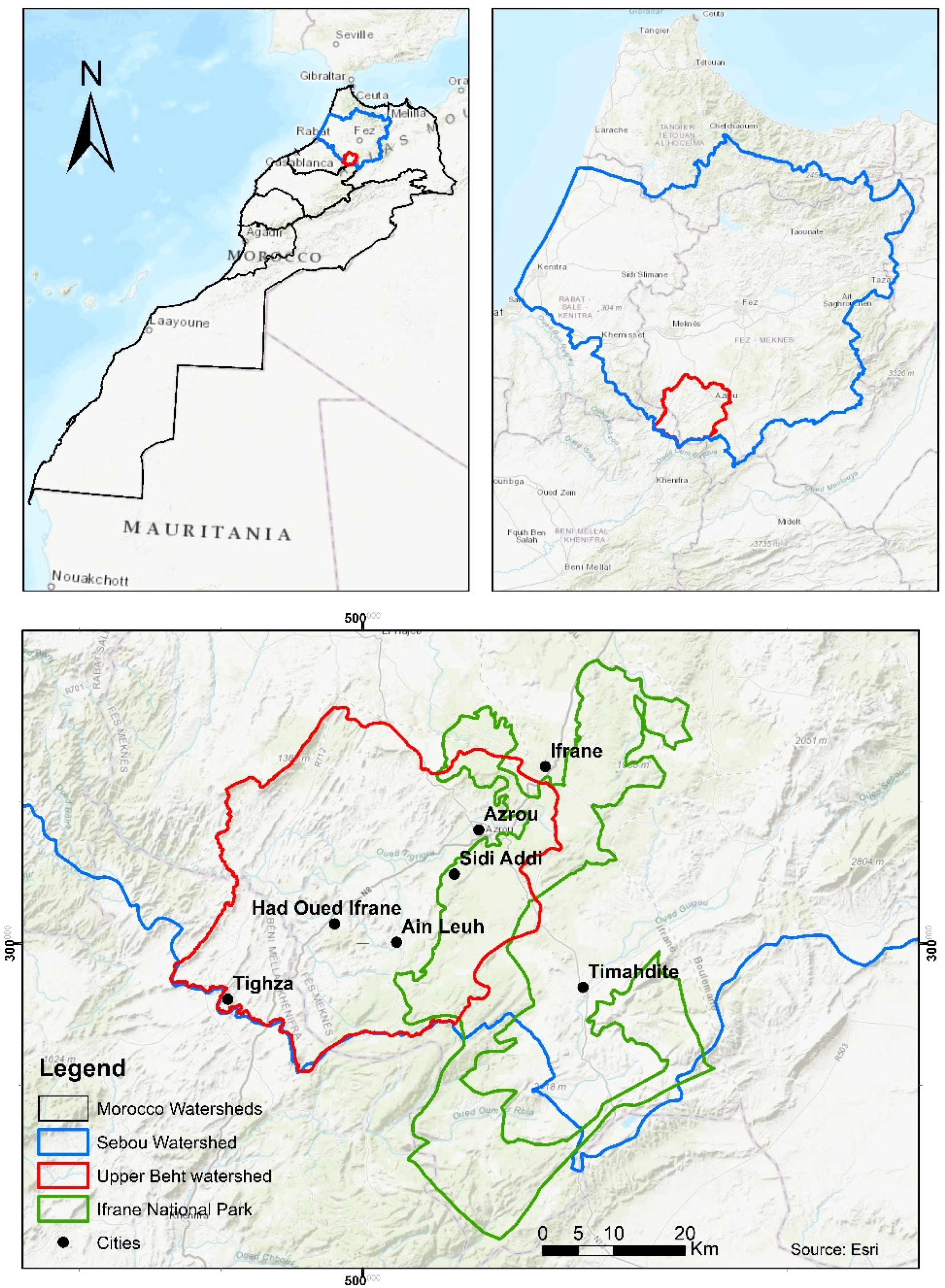


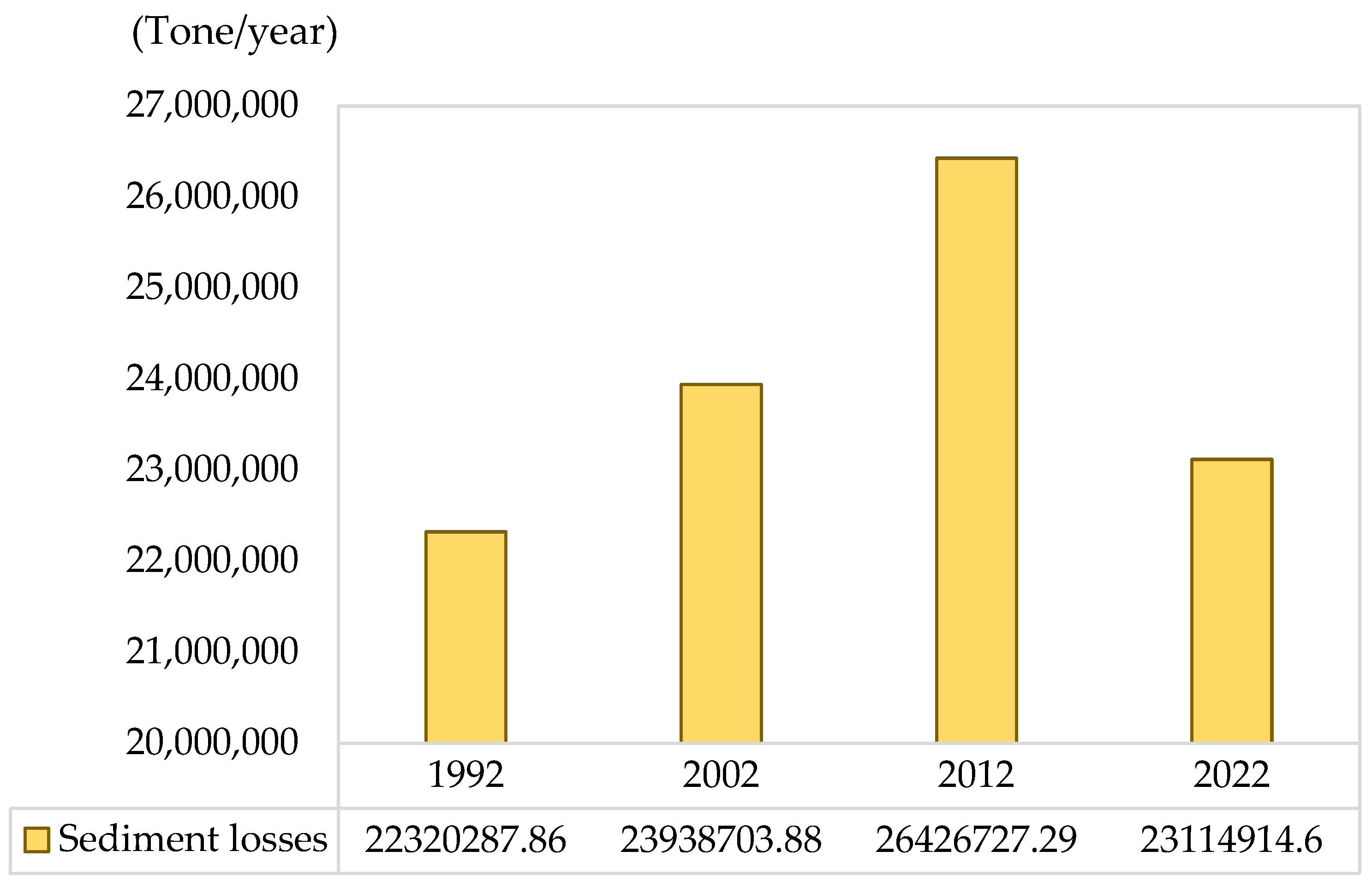
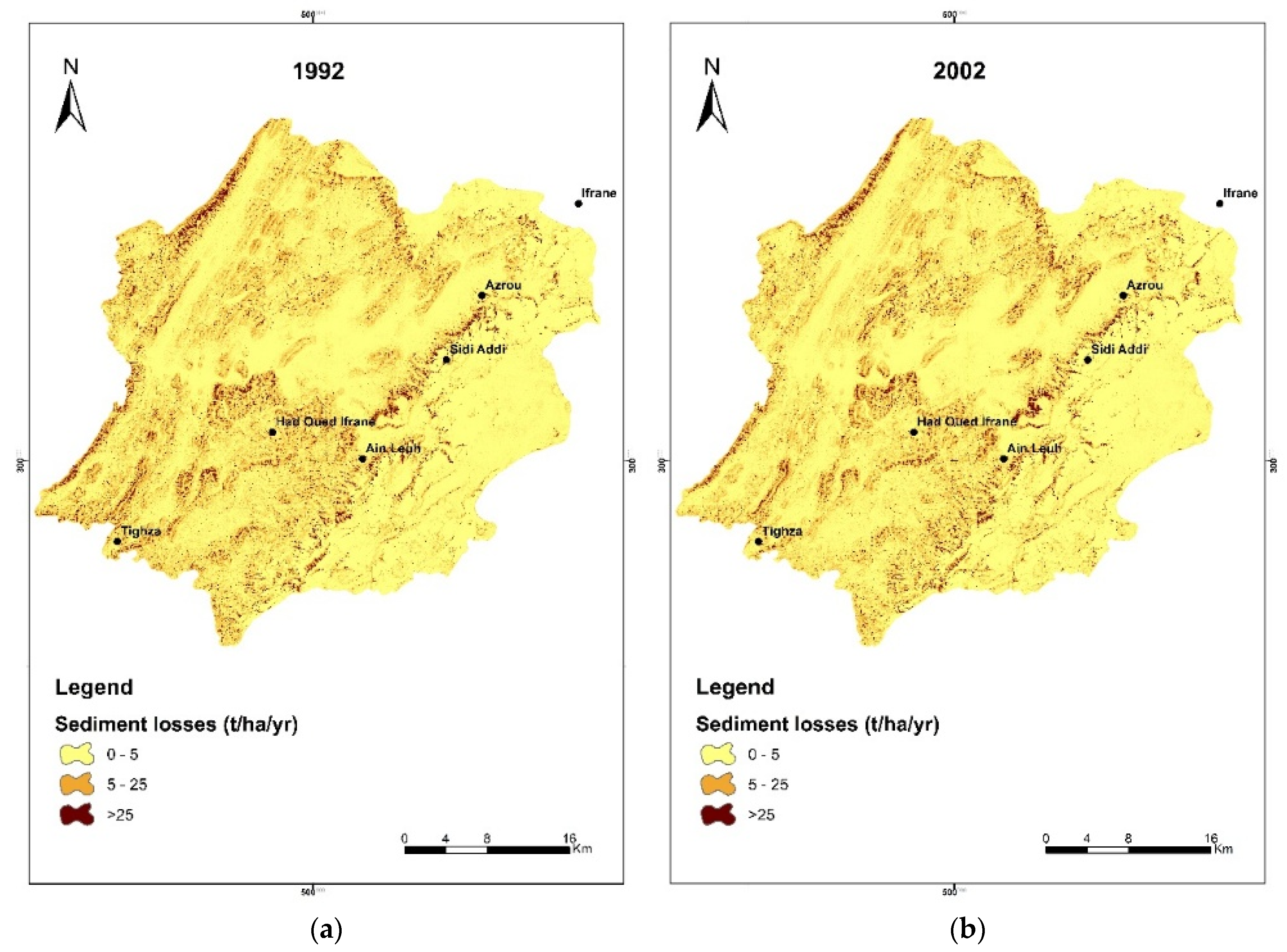

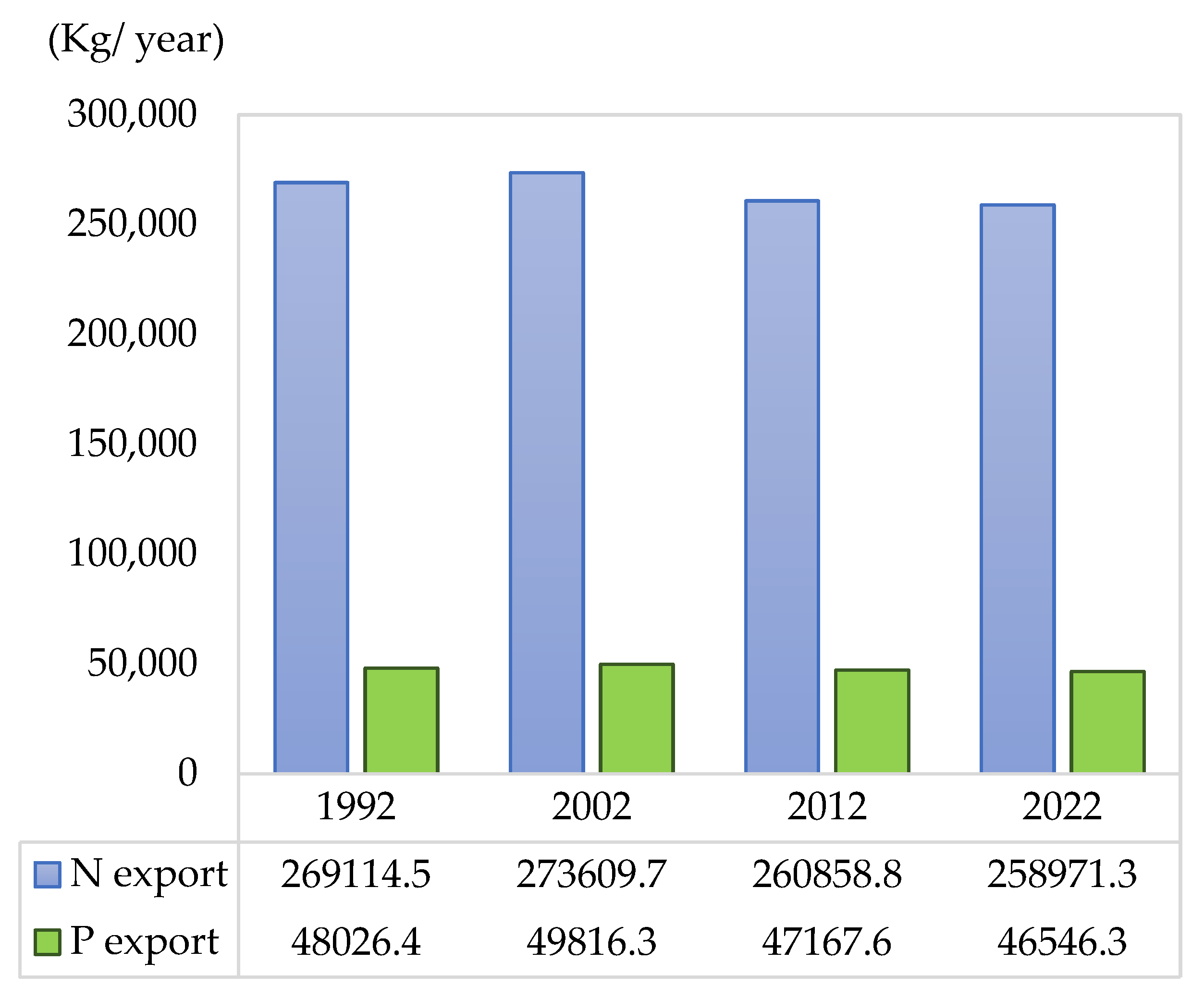


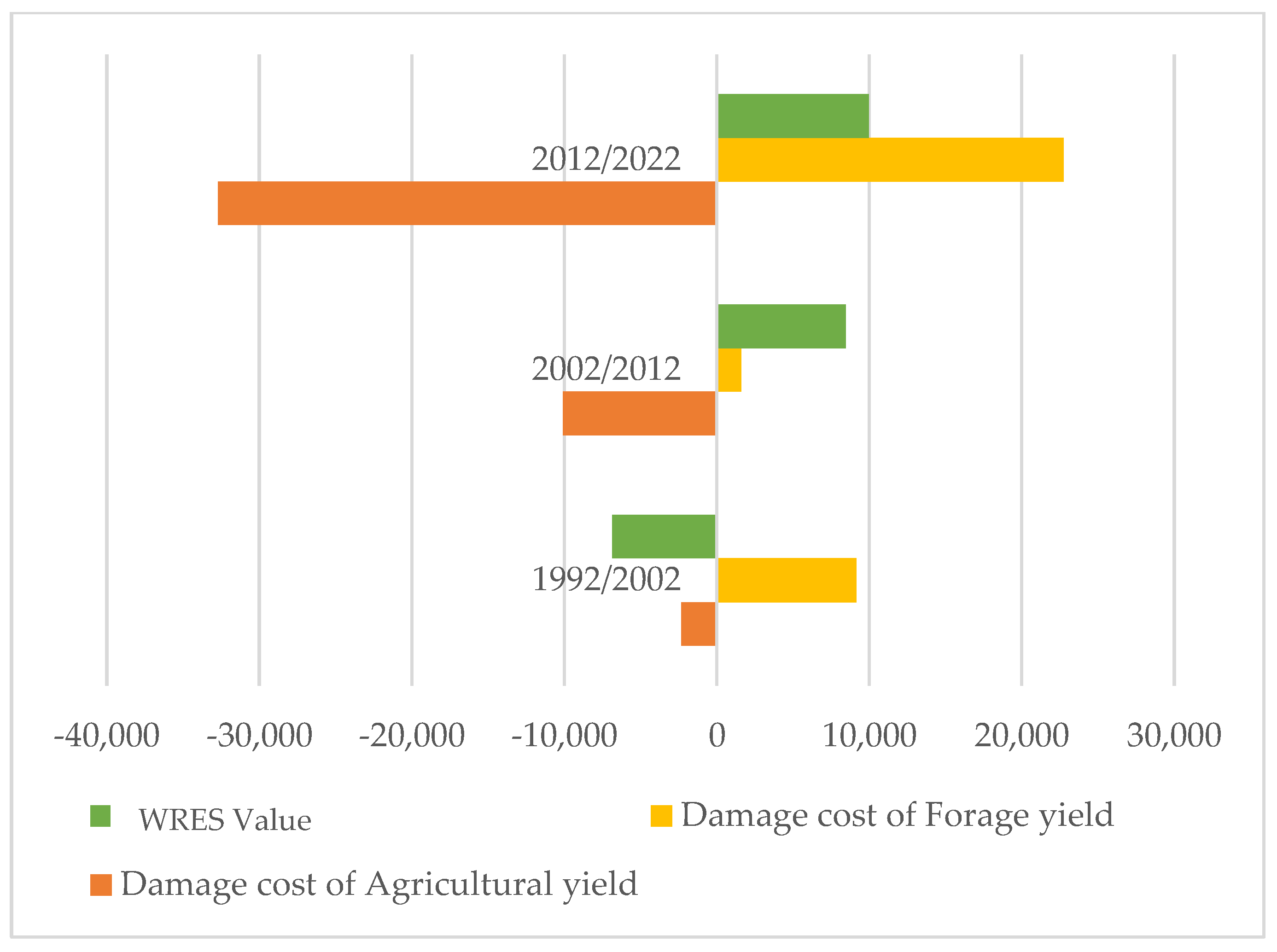
| Models Inputs | InVEST Models | Source of Inputs |
|---|---|---|
| LULC | All InVEST models | Obtained using Google Earth engine platform |
| Biophysical tables (*) | All InVEST models | From literature [36,37] |
| Rasters of precipitation | “Nutrient Delivery Ratio” | Obtained from the website of CHIRPS [38] |
| Digital elevation model | “Sediment Delivery Ratio” “Nutrient Delivery Ratio” | From the website of Earth Science Data Systems (ESDS) [39] |
| Erosivity raster (R Factor) | “Sediment Delivery Ratio” | Calculated from annual and monthly precipitation averages over a 30-year period (1992–2022) obtained from the website of CHIRPS, using the formula of Rango and Arnoldus (1987) [38,40] |
| Soil erodibility raster (K factor) | Obtained by attributing the corresponding k factor values [36] to the lithologic facies of the study area |
| Erosion Classes (t/ha/Year) | Loss of Forage Productivity (%) |
|---|---|
| 0–5 | 2.5 |
| 5–25 | 25 |
| >25 | 45 |
| LU Class | Surface in 1992 (Ha) | Surface in 2002 (Ha) | Surface in 2012 (Ha) | Surface in 2022 (Ha) |
|---|---|---|---|---|
| Crops | 6999 | 11,762 | 12,456 | 18,502 |
| Bare soil | 47,150 | 46,535 | 54,074 | 58,242 |
| Water | 89 | 97 | 96 | 49 |
| Built-up | 14 | 79 | 106 | 976 |
| Forest | 19,564 | 17,592 | 16,058 | 20,476 |
| Shrubs | 95,365 | 93,116 | 86,391 | 70,936 |
| Total | 169,181 | 169,181 | 169,181 | 169,181 |
| 1992 | 2002 | 2012 | 2022 | |
|---|---|---|---|---|
| Kappa coefficient | 89% | 91.3% | 93.8% | 98.14% |
| Soil Loss Class (t/ha/Year) | Erosion Rate Ewp (t/ha/Year) | Decrease in Yield: r (%) | Decline in Yield ∆R = rxAverage Yield (2 t/Ha) (t/ha) | Annual Cost 1992/2002 (USD/Year) | Annual Cost 2002/2012 (USD/Year) | Annual Cost 2012/2022 (USD/Year) |
|---|---|---|---|---|---|---|
| 0–5 | 2.5 | 0.04 | 0.07 | 9255.9 | 1427 | 2219.8 |
| 5–25 | 15 | 0.31 | 0.06 | −81.6 | 177 | 501.6 |
| >25 | 25 | 0.59 | 0.12 | −6.8 | 8.6 | 46.9 |
| Total | 9167.6 | 1612.7 | 22,741.4 |
| Soil Losses (t/ha) | Loss of Forage Productivity (%) | Loss of Forage Productivity (UF/ha) | Annual Cost (USD/Year) | Annual Cost (USD/Year) | Annual Cost (USD/Year) |
|---|---|---|---|---|---|
| 0–5 | 2.5 | 3.3 | −902.1 | −6284.8 | −20,784.5 |
| 5–25 | 25 | 32.9 | −1307.4 | −3618.6 | −10,803.3 |
| +25 | 45 | 59.3 | −104.7 | −179.8 | −1122.9 |
| Total | −2314.2 | −10,083.1 | −32,710.8 |
Disclaimer/Publisher’s Note: The statements, opinions and data contained in all publications are solely those of the individual author(s) and contributor(s) and not of MDPI and/or the editor(s). MDPI and/or the editor(s) disclaim responsibility for any injury to people or property resulting from any ideas, methods, instructions or products referred to in the content. |
© 2025 by the authors. Licensee MDPI, Basel, Switzerland. This article is an open access article distributed under the terms and conditions of the Creative Commons Attribution (CC BY) license (https://creativecommons.org/licenses/by/4.0/).
Share and Cite
Sadgui, O.; Khattabi, A.; Dichane, Z. Spatio-Temporal Evolution of Water-Regulating Ecosystem Services Values in Morocco’s Protected Areas: A Case Study of Ifrane National Park. Land 2025, 14, 831. https://doi.org/10.3390/land14040831
Sadgui O, Khattabi A, Dichane Z. Spatio-Temporal Evolution of Water-Regulating Ecosystem Services Values in Morocco’s Protected Areas: A Case Study of Ifrane National Park. Land. 2025; 14(4):831. https://doi.org/10.3390/land14040831
Chicago/Turabian StyleSadgui, Oumayma, Abdellatif Khattabi, and Zouhir Dichane. 2025. "Spatio-Temporal Evolution of Water-Regulating Ecosystem Services Values in Morocco’s Protected Areas: A Case Study of Ifrane National Park" Land 14, no. 4: 831. https://doi.org/10.3390/land14040831
APA StyleSadgui, O., Khattabi, A., & Dichane, Z. (2025). Spatio-Temporal Evolution of Water-Regulating Ecosystem Services Values in Morocco’s Protected Areas: A Case Study of Ifrane National Park. Land, 14(4), 831. https://doi.org/10.3390/land14040831







